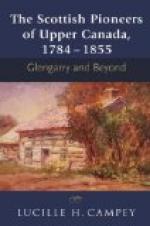For a month or more Hearne camped in this fashion by the side of a lake, waiting till the season was sufficiently open for him to continue his journey by water. He and his party of Indians lived mainly on fish, but when these became scarce they attempted to snare grouse or kill deer. In the intervals of rare meals all the party smoked or slept, unless they were obliged to go out to hunt and fish. They would delight, after killing deer, in securing as much as possible of the blood and turning it into broth by boiling it in a kettle with fat and scraps of meat. This was reckoned a dainty dish. Their spoons, dishes, and other necessary household furniture were cut out of birch bark.
[Illustration: LAKE LOUISE, THE ROCKY MOUNTAINS]
By the 19th of May, geese, swans, ducks, gulls, and other birds of passage were so plentiful, flying from south to north, and halting to rest at the lake, that Hearne felt the time had come to resume his journey, provisions being now very plentiful and the worst of the thaw over. The weather was remarkably fine and pleasant as the party travelled northwards.
There must have been good patent medicines even in those days. Of these Hearne possessed “Turlington’s Drops” and “Yellow Basilicon”, and with these he not only healed the terrible wounds of a valuable Indian who had cut his leg most severely (when making birch-bark dishes, spoons, &c), but also the hand of another Indian, which was shattered with the bursting of a gun. These medicines soon restored the use of his hand, so that in a short time he was out of danger, while the carver of birch-bark spoons was able to walk. Nevertheless, although they were to the south of the 60th degree of latitude, the snow was not completely melted until the end of June.
All at once the weather became exceedingly hot, the sledges had to be thrown away, and each man had to carry on his back a heavy load. For instance, Hearne was obliged to carry his quadrant for taking astronomical observations, and its stand; a trunk containing books and papers, &c.; a large compass; and a bag containing all his wearing apparel; also a hatchet, a number of knives, files, &c., and several small articles intended for presents to the natives—in




